While I was taking my practice GMAT tests, I always wondered how to keep track of time on GMAT. If you’re aiming for a score of 700 or more, a reliable GMAT time management strategy is critical to your success.
In this article, I’ll share my top tips from the GMAT timing strategy I used to score 710 on the GMAT.
Using these tips, I finished the quantitative reasoning section with 2 minutes to spare. And after I answered the last question in the verbal reasoning section, I had 5 minutes remaining.
10 Awesome Tips on How to Keep Track of Time on GMAT
Here are 9 awesome tips on how to keep track of time on GMAT:
- Balance Time, Pacing, Difficulty, and Accuracy
- Stagger Your Mistakes Instead of Clustering Them
- Use the Scoring Algorithm to Your Advantage
- Avoid Micro-Managing Your Time During the Test
- Memorize Milestones for Each 15-Minute Block of Time
- Use Full-Length Practice Tests to Rehearse Pacing
- Make Educated Guesses to Make-Up for Lost Time
- Allocate More Time to Solve DS, RC, and CR Questions
- Allocate Less Time to Solve PS and SC Questions
- Learn Tactics to Identify Questions Worth Skipping
In the following sections, I’ll go over each of these tips in detail.
Balance Time, Pacing, Difficulty, and Accuracy
Creating an effective GMAT time management strategy requires you to balance the four aspects shown in the figure below:
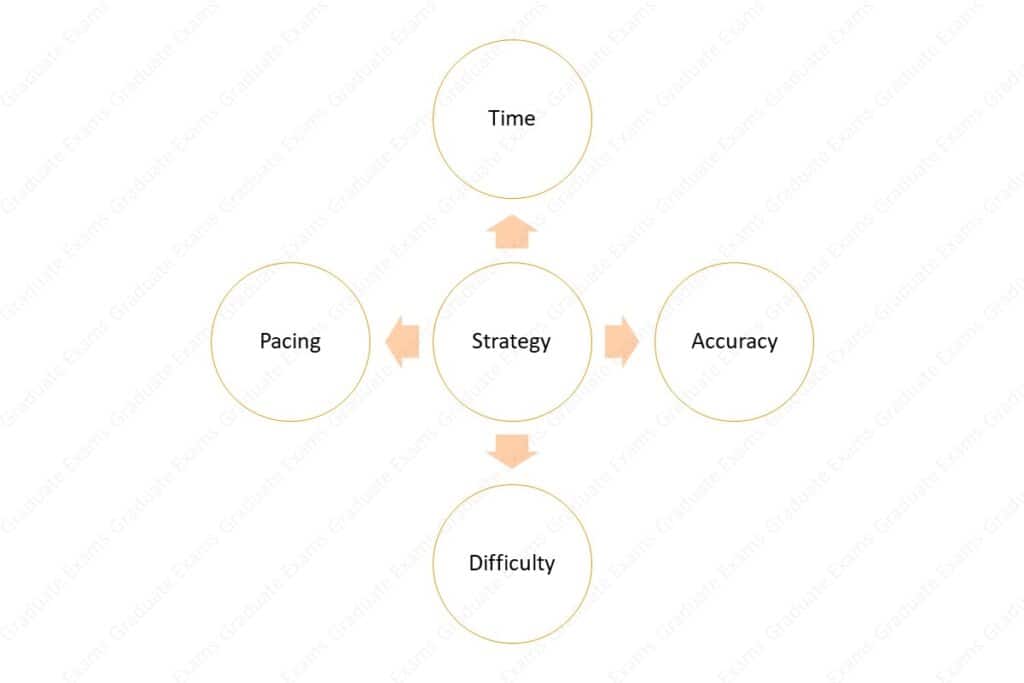
These aspects are:
- Time
- Pacing
- Difficulty
- Accuracy
Before you learn how to balance these four aspects, you need more information. Let’s go over each one in detail.
Time
Time refers to the amount of time you spend on a question. GMAT has four sections:
- Analytical Writing Assessment
- Integrated Reasoning
- Quantitative Reasoning
- Verbal Reasoning
Each section, except the analytical writing assessment section, has multiple question formats. The analytical writing assessment has one question format. The question format for each of the above sections are:
- Analytical Writing Assessment
- Analysis of an Argument
- Integrated Reasoning
- Multi-Source Reasoning
- Table Analysis
- Graphics Interpretation
- Two-Part Analysis
- Quantitative Reasoning
- Problem Solving (PS)
- Data Sufficiency (DS)
- Verbal Reasoning
- Reading Comprehension (RC)
- Critical Reasoning (CR)
- Sentence Correction (SC)
Within each section, the question formats are chosen at random. However, you will come across all the formats during your test.
Since GMAT tests you on such a wide range of question formats, your time management strategy must account for how much time you spend on a question of a given format.
For instance:
Your strategy may require you to spend more time on reading comprehension questions than you do on sentence correction questions.
Pacing
Pacing is different from time. While time refers to the amount of time you spend on a question, pacing refers to the number of questions you must solve for a given block of time.
A simple example will help clarify the distinction between time and pacing.
The quantitative reasoning section has 31 questions in it. You get 62 minutes to answer these questions. Therefore, the average time you spend on each question is 2 minutes. At this rate, you must pace yourself at 15 questions in the first 30 minutes and the rest before the time runs out.
However, finding the right pace is not as simple as the example above suggests. We will explore pacing in much more depth as we proceed. For now, the takeaway is this:
Your GMAT timing strategy must look at how much time you spend on each question as well as how many questions you do in a standard block of time.
Difficulty
Difficulty represents the probability of answering a question correctly for a given level of skill. For example, a person with highly developed quantitative reasoning skills has a higher probability of answering a question correction than a person with poorly developed quantitative reasoning skills does.
GMAT collects data from all test takers through experimental questions to calculate the probability of answering the question correctly for a given score.
For example:
According to GMAT, a 700-level question is a question which a person who scores a 700 on the GMAT has a 60-70% probability of answering correctly. In other words, if the question were given to 100 people who scored 700 on the GMAT, 60-70 of them would answer it correctly.
To get a score of 700 on the GMAT, you must answer demonstrate to the algorithm your ability to maintain 60-70% accuracy in answering 700-level questions.
This brings us to the next aspect – accuracy.
Accuracy
Accuracy is the number of questions you answer correctly as a percentage of the number of questions you attempt.
For example, if I answer 7 questions correctly out of the 10 questions I attempted, then my accuracy is 70%.
Maintaining an accuracy of 60% or more is important because without a high accuracy rate, the GMAT algorithm will not expose you to questions from higher difficulty levels.
For instance, a candidate who has an accuracy of 40% is unlikely to see more than a few 700-level questions. At the same time, a candidate who maintains an accuracy of 60% or more is likely to see many 700-level questions.
Payoff and Cost Relations
You might already sense the correlation between the four aspects. But the table below will make the relationship between the payoff and cost for favoring one aspect over the others:
- Timing: If you choose to spend more time on each question, your accuracy will increase. As your accuracy increases, the difficulty increases. However, because of your spending too much time on each question, your pacing suffers, and you incur a penalty for not completing the test.
- Pacing: If you focus on maintaining your pre-decided pace, you might have to guess or skip questions to make up for lost time. Thus, your accuracy drops. Also, the time you spend becomes erratic – you might take minutes to answer one question but seconds to attempt the next. Since your accuracy drops, the difficulty of the questions you get also drops. However, focusing on you pacing helps you avoid the penalty for not completing the test.
- Accuracy: If you insist on answering every question you get correctly, you’ll answer the easy questions quickly and hard questions slowly. Because of this, you’ll finish ahead of time for the first half of the test and not have enough time for the second half of the test. Since you were able to maintain high accuracy at the start of the test, you’ll score in the 620-670 range. However, since you didn’t answer enough hard questions, you cannot get a +700 score.
- Difficulty: Centering your time management strategy around the difficulty of questions is a poor strategy. The main reason for this is that difficulty is a data-driven, objective parameter. Therefore, you cannot subjectively determine the difficulty of a question. If you try to do so, you’ll make inaccurate assumptions. And you’ll waste precious time figuring out the difficulty.
Therefore, a sound GMAT time management strategy must balance the four aspects at the same time. Here’s how I would put it:
Your GMAT strategy must set the pace for each section and question format so that you can maintain high accuracy because of which you can answer questions of higher difficulty and get a high score.
Easier said than done. But the read the rest of the tips to learn how to achieve this balance.
Stagger Your Mistakes Instead of Clustering Them
The figure below shows two cases. In both cases, the accuracy is the same – 70%. However, in the first case the three errors form a cluster. And in the seconds case the three errors are staggered.
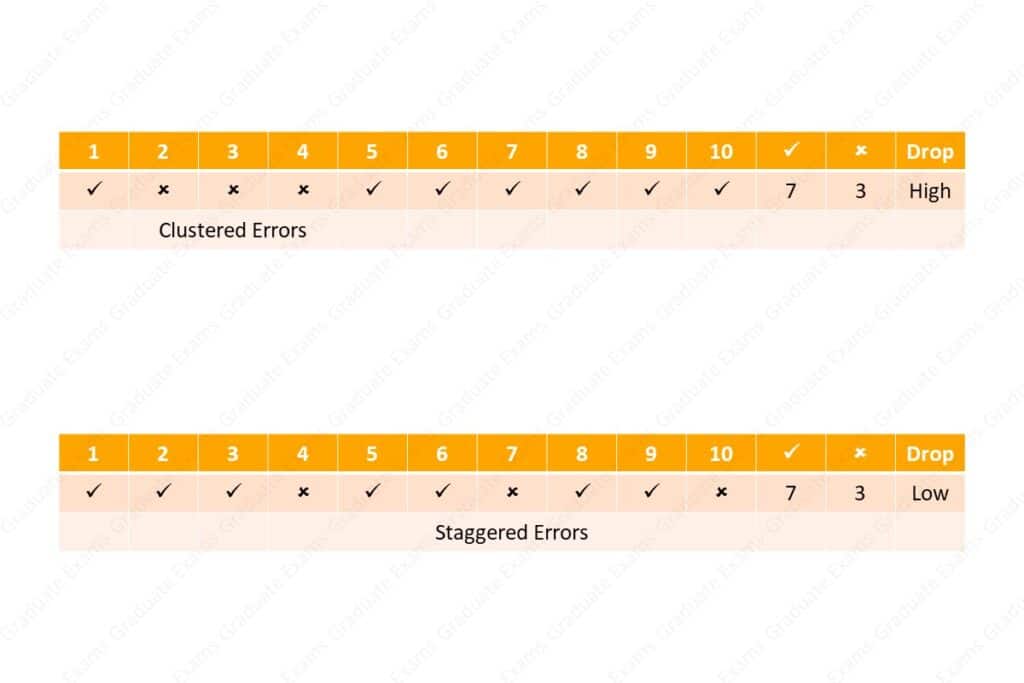
A non-adaptive algorithm would score the two cases the same way. However, GMAT is an adaptive test. Thus, the GMAT algorithm penalizes clustered errors more severely than it does staggered errors.
The mention of penalty might conjure the wrong picture – GMAT does not have any negative marking. Instead, GMAT lowers its estimate of your ability. Here’s what I mean:
In the first case – the case where the test taker answered 3 question incorrectly – here’s what the GMAT algorithm sees:
- Okay, you answered question 2 incorrectly. Let me give you an easier one.
- What, you answered question 3 incorrectly too? Oh well, let me give you an even easier one.
- Sheesh, you answered question 4 incorrectly as well? My… I guess I’ll have to give you something really simple, right?
- Oh, great you answered question 5 correctly! Now, let’s stick to this level for a while.
Can you see how the GMAT algorithm is lowering the bar for you? That’s not what we want. We want GMAT to set the bar at 700 as soon as possible.
Does this mean you must answer all the questions correctly? Well, no – we’ve already discussed the problems with that. Instead, you must be careful not to cluster your errors.
Let’s look at how the GMAT algorithm sees the second case:
- Hmmm…. You answered number 4 incorrectly. Let me throw you an easier one.
- Cool, you had no problems with number 5. I guess number 4 was an anomaly. Let’s continue.
Are you able to see how the GMAT algorithm sees that one mistake as an anomaly? When you maintain a streak of correct answers with mistakes scattered few and far between, the algorithm sees the mistakes as anomalies. Thus, GMAT does not drastically lower its estimate of your ability.
You can afford to miss a few questions here and there. You can even choose to blindly guess the answer to a question so that you can maintain your pacing.
Use the Scoring Algorithm to Your Advantage
When you start the test, GMAT’s scoring algorithm knows nothing about your abilities. So, it spends the first 1/3rd of the questions to make a rough estimate of your abilities.
Once it has a rough estimate of your abilities, it spends the next 1/3rd of the questions to narrow its estimate.
In the last 1/3rd of the questions, the algorithm to improve its confidence in its estimate.
The figure below shows these three stages:

So, how do you take advantage of the algorithm? Well, you do that by making fewer mistakes in the beginning.
Strategy for the First 1/3rd
While answering the first 1/3rd of the questions, focus on maintaining an accuracy of 80% or more even if your pacing is slow. Also, avoid error clusters at all costs. An error cluster at this stage can devastate your GMAT score.
By maintaining high accuracy and avoiding error clusters, the GMAT algorithm will realize there’s no point in testing you on easy questions.
Strategy for the Second 1/3rd
So far, you’ve convinced the algorithm that you’re more than capable of handling easy or maybe even moderate questions. Therefore, in the second 1/3rd of the questions, the GMAT algorithm tries to establish the limit of your ability.
At this stage, you’ll see hard questions. However, you can no longer continue to maintain the slow pace you had at the beginning. Naturally, your accuracy will drop. But you must keep the accuracy above 60% and stagger your mistakes. Also, be mindful of your pacing.
By the time you finish the second 1/3rd of the questions, the GMAT algorithm will have a narrow estimate of your score. It might be 1-2 points away from your final score.
But GMAT will run a few checks to eliminate any false positives.
Strategy for the Last 1/3rd
In the last 1/3rd the GMAT algorithm performs checks to see whether it made any mistakes in its estimates.
It does this by exposing you to a mix of questions to improve its confidence. The algorithm is just trying to be sure.
So, in the last 1/3rd the algorithm makes only fine adjustments to your score. However, you must still avoid error clusters.
Also, make sure you answer all the questions in the section before the time runs out. The algorithm drops your score by a huge amount for every question you leave unanswered.
Even blindly guessing the last couple of questions is better than not answering them at all.
I can understand that your head might be spinning from all factors you must account for. And you might think you must micro-manage the time you spend on each question. Well, that’s not true. Let’s see the problems with micro-managing your time.
Avoid Micro-Managing Your Time During the Test
When I took my first full-length practice test, I used to look at the timer all the time. I checked the time after each question. Sometimes, I checked the time a couple of times while solving a question.
And in my head, I kept calculating my speed; all the while trying to guess whether I am fast enough.
All this created stress. The stress didn’t allow me to think right. I panicked. Made many mistakes. And did terribly.
Contrast this with my last full-length practice test.
In my last full-length practice test, I might have looked at the time 3-4 times during the entire test. I was relaxed and I was in the flow. I was confident in my abilities and I knew I would get the score I wanted.
On the actual GMAT, I have scored more than 700 twice – a 710 and a 750. During both attempts I didn’t obsess over time.
At the same time, you shouldn’t be oblivious of the time. So, you must set milestones to show your where you need to be at a certain point in time. In the next section, we’ll discuss the milestones in detail.
Memorize Milestones for Each 15-Minute Block of Time
This section is probably the most valuable part of this entire article. In this section, I’ll show you the best pacing for each section of GMAT. Let’s look at the quantitative reasoning section first.
Milestones for the Quantitative Reasoning Section
The quantitative reasoning section has 31 questions. You must attempt all the 31 questions within 62 minutes. GMAT will lower your quant raw score significantly for each question you leave unanswered. Here’s the recommended pacing strategy for this section.
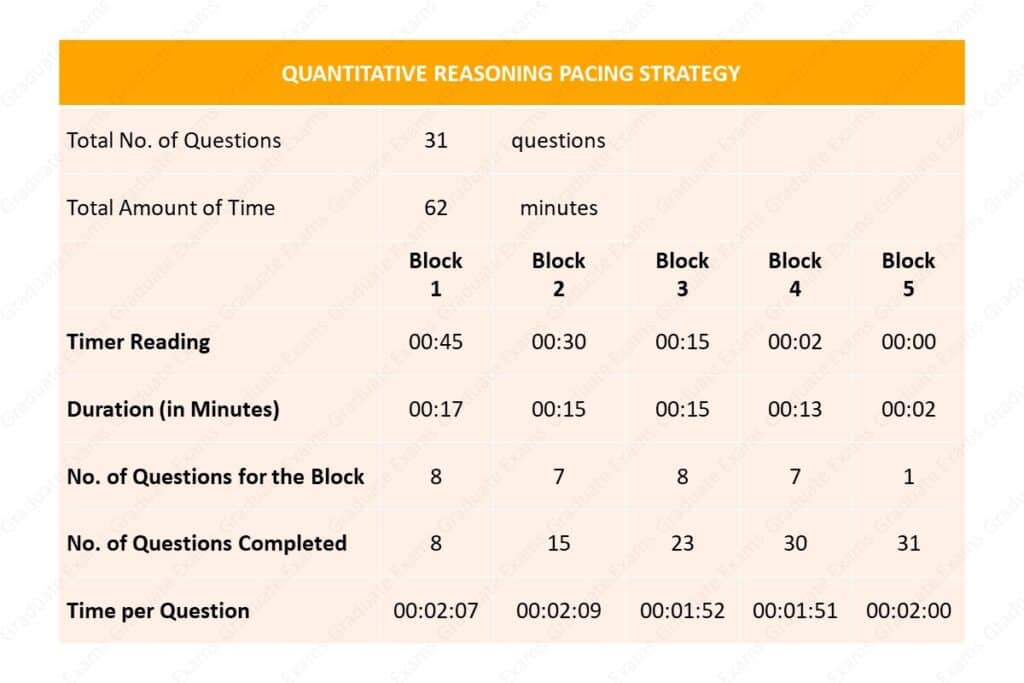
In the figure above you can see that I’ve divided the total time into 5 blocks. The table shows you how many questions you should complete in each block along with how many questions you must complete over all at the end of each block.
Milestones for the Verbal Reasoning Section
The verbal reasoning section has 36 questions. You must attempt all the 36 questions within 65 minutes. GMAT will lower your verbal raw score significantly for each question you leave unanswered. Here’s the recommended pacing strategy for this section.

In this figure, you will see that I have divided the total time into 5 blocks. The timer reading for each block in the verbal reasoning section is the same as the reading for the quantitative reasoning section. However, the number of questions is different.
I recommend you memorize the pattern for quant and verbal section. But the rule of thumb is that you must have solved around half the total number of questions by the time the timer reaches 00:30:00.
Milestones for the Integrated Reasoning Section
The integrated reasoning section has 12 questions. You must answer them within 30 minutes.
However, the integrated reasoning section isn’t adaptive. Thus, there’s no penalty for leaving questions unanswered.
Nevertheless, to score in the 80th percentile, you’ll need to attempt all the questions. Here’s the recommended pacing for integrated reasoning:
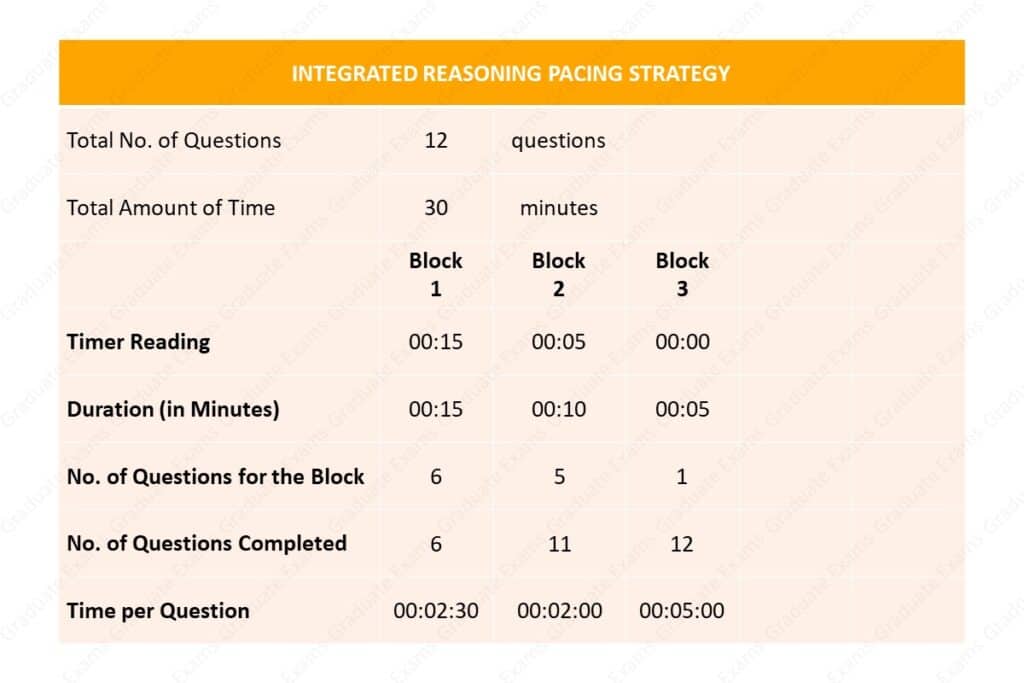
I’ve divided the total time into 3 blocks. I’ve made the third block disproportionately long to build a buffer. If you’re able to finish 6 questions by the time the timer reaches 00:15:00, you’re good to go.
Milestones for the Analytical Writing Assessment Section
Pacing for the analytical writing assessment section is tricky. Unlike other sections, which have multiple questions, the AWA section has only one question.
In this section, you must analyze an argument. Analyzing an argument mostly involves identifying the assumptions and poking holes in the reasoning.
Thus, instead of questions, I’ve used the steps you need to complete as milestones. Here’s the pacing for the AWA section.
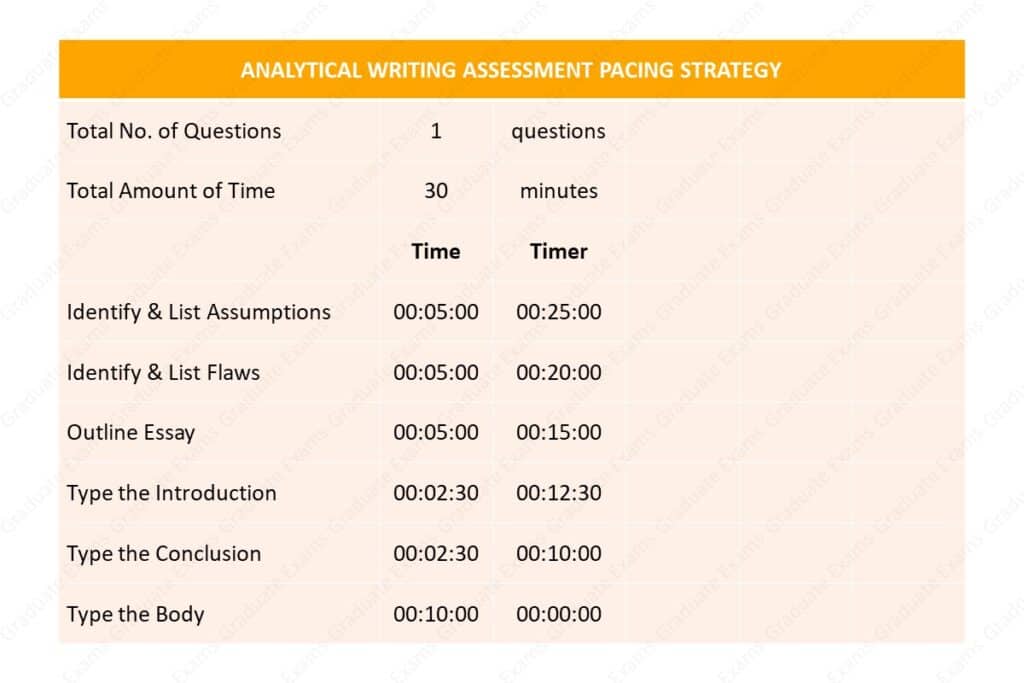
The key thing here is to not start writing as soon as you see the argument. Take the first 15 minutes to identify the assumptions, list the flaws in the argument, and create an outline.
In the next 15 minutes, write the introduction, conclusion, and body. I recommend writing the conclusion immediately after writing the introduction otherwise you might miss writing a conclusion. Then write the body between the introduction and the conclusion. Be mindful of your grammar and use simple words to avoid spelling mistakes.
Use Full-Length Practice Tests to Rehearse Pacing
Once you memorize the milestones for each section, the next step is to internalize the rhythm. To do this, you must take full-length practice tests.
Taking full-length practice test also trains you to stay focused for 3 hours and 23 minutes.
You might find taking your first full-length practice test demanding. But once you finish the recommended six full-length practice tests, you’ll see that once you get into the groove you don’t realize how quickly time flies.
In my case, I got into the zone after finishing the analytical writing assessment section. Thereafter, I approached the test one question at a time.
Yes, I saw the clock ticking in the corner. But the timer didn’t bother me. My training kicked in and I followed the drill. I got into my rhythm and before I knew it, I finished the test and scored 710. The same thing happened when I scored 750.
So, rehearsing the pacing by taking full-length practice tests is crucial. I recommend using Manhattan Prep’s Computer Adaptive Practice Exams for taking full-length practice tests. Also, the assessment report after each Manhattan test will give you the following data:
- Average time spend per question by section, topic, and question format.
- Average level of difficulty by section, topic, and question format.
- Average accuracy by section, topic, and question format.
The report will also show you how effectively you avoid error clusters and stagger your errors.
You have all the information you need regarding pacing in this article. Now, all you need is practice. Next, I’ll share a few advanced tips to help you manage your time on the GMAT.
Make Educated Guesses to Make-Up for Lost Time

The table above shows the probability of guessing a question’s answer correctly or incorrectly for the corresponding number of active options.
From the table, you can see that a blind guess has only a 20% chance of being correct.
If you eliminate one answer choice, you have a 25% chance of being correct. By eliminating one answer choice, you have improved your chances by 25%.
And if you can reduce the number of active answer choices to 2, then you have a 50% chance of guessing the answer correctly. In other words, you’ve doubled your chances of answering the question correctly.
So, mastering the process of elimination can greatly help improve your ability to make educated guesses about the answer.
Why is this important?
As you progress through the test, you may find yourself falling behind. To make up for lost time, you may have to answer a few questions in less than 30 seconds.
30 seconds may be enough for easy questions and certain question formats. In most cases, you’d have to make an educated guess if you must answer the question within 30 seconds.
Process of elimination works well for data sufficiency and sentence correction. So, when you practice these question formats, let the process of elimination be the default strategy.
You can also borrow time from certain question formats and invest the time into other more time-consuming formats. More on that in the next two points.
Allocate More Time to Solve PS, RC, and CR Questions
When I analyzed my performance in the full-length practice tests, I realized that my accuracy for 700-level questions improved when I gave myself 20-30 extra seconds for the following question formats:
- Problem Solving
- Reading Comprehension
- Critical Reasoning
Here’s why the accuracy increased:
On reviewing the questions, I answered incorrectly, I realized that I didn’t answer them incorrectly because I didn’t know how to answer them.
Instead, I answered them incorrectly because I rushed myself. And most of the time, I found myself rushing on the question formats I mentioned above. As soon as I stopped rushing, my accuracy improved.
But I knew that taking extra time to solve these questions would disrupt my pacing. So, I decided to reduce the time I spent on data sufficiency and sentence correction questions.
Allocate Less Time to Solve DS and SC Questions
A data sufficiency question is a blessing, albeit in disguise. On the surface, you may think that data sufficiency questions take more time than problem solving questions.
I understand that testing sufficiency is complicated. But here’s a trick to data sufficiency that makes it a wonderful opportunity for making educated guesses:
- Test the sufficiency for the second statement.
- If the second statement is sufficient, you can eliminate options A, C, and E. This leaves only options B and D as your active answer choices. Now, you have a 50% chance of guessing the answer correctly.
- If the second statement is not sufficient, you can eliminate options B and D. This leaves only options A, C, and E as your active answer choices. Now, you have a 33.33% chance of guessing the answer correctly.
Thus, by testing the sufficiency of just one statement, you can improve your chances of making an educated guess to at least 33.33%.
I recommend using this process of testing sufficiency criteria for all data sufficiency questions you solve.
As for sentence correction questions, you can use a method called split-testing to eliminate answer choices. Here’s a simple example:
A dog usually wags its tail when it sees it’s master to express its happiness.
- its tail when it sees it’s master to express its
- it’s tail when it sees its master to express its
- it’s tail when it sees it’s master to express its
- its tail when it sees it’s master to express it’s
- its tail when it sees its master to express its
Usually, people plug each option into the question to check whether the sentence sounds right. But this approach doesn’t work. It certainly won’t for this question because phonetically the words its and it’s are the same. So, how do you solve the question?
- First, I identify a split. I can see that options A, D, and E start with its and options B and C start with it’s. So, I have a 3-2 split between its and it’s.
- Next, I check which is the correct split. In this case the correct split is “its”.
- Then, I eliminate all options with the incorrect split. In this case, I eliminate options B and C. At this point, if I were to guess the answer, I have a 33.33% chance of guessing correctly.
- Now, in the remaining options, I can look for another split. Options A and D have an it’s in the middle and option E has an its in the middle. Now, I have a 2-1 split between it’s and its.
- After eliminating the incorrect split (it’s) I get the right answer – option E.
Once you learn the split method, the process of elimination will become your default method of solving these problems.
Using the BD-ACE strategy for data sufficiency questions and the split-testing method for sentence correction questions, you can either solve these questions or make an educated guess within 30 seconds.
Learn Tactics to Identify Questions Worth Skipping
The best advice I’ve heard about taking the GMAT is – “Don’t get tangled with any question.” If you get into an ego-clash with a question to see who prevails, you’ll ruin your GMAT score.
Doing well on the GMAT is as much about the questions you attempt as it is about questions you skip. On the GMAT, you can’t skip a question in the real sense because GMAT does not display the next question until you answer the one before you.
When I say skip, I really mean not spending more than 10 seconds on the question. Therefore, you should be able to decide whether to skip a question immediately after you finish reading the question.
I ask myself a few questions to decide whether to skip a question:
- Have I solved a question exactly like this one or similar to this one before?
- Do I know which topic this question is from? Am I familiar with the concepts in that topic?
- Can I use any methods to reduce the number of active options?
- Am I sticking to my pacing?
If I don’t get a yes for at least 2 questions, I might skip the question and hope for a better one.
Also, avoid skipping questions in the first 1/3rd of the test. And don’t skip more than two questions in a row. If you’re unfortunate, you might create an error cluster.
Conclusion
From these top tips on how to keep track of time on GMAT, I’m sure you can create a GMAT time management strategy for yourself.
However, after creating the strategy, you must internalize the strategy so that you don’t think about your pacing all the time.
To develop an internal rhythm, you need preparation and practice. If you need help with that, I recommend reading my article on how to prepare for the GMAT in 3 months.
